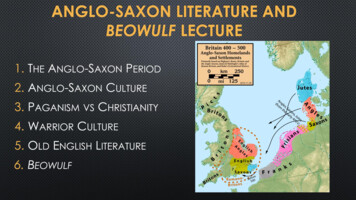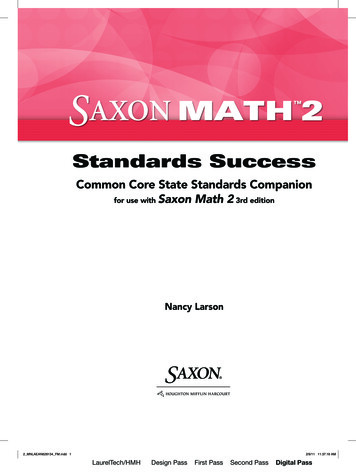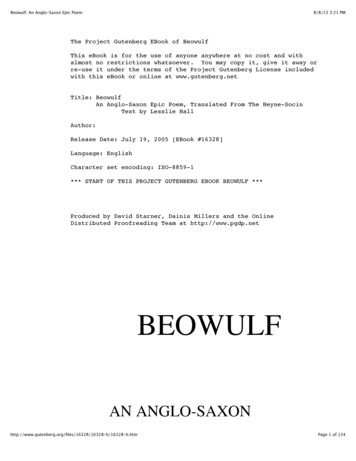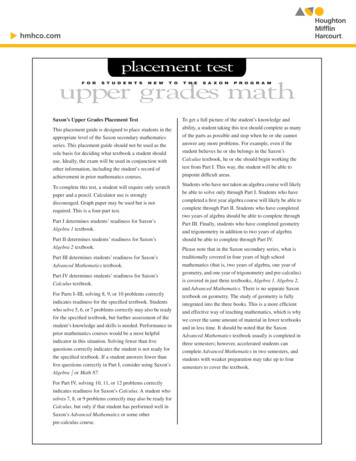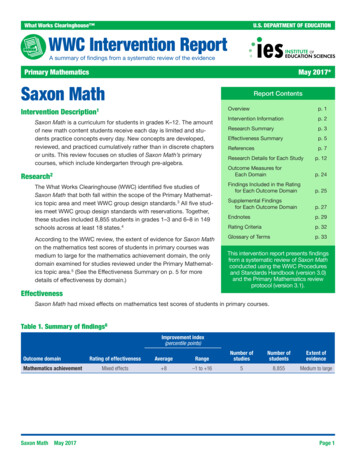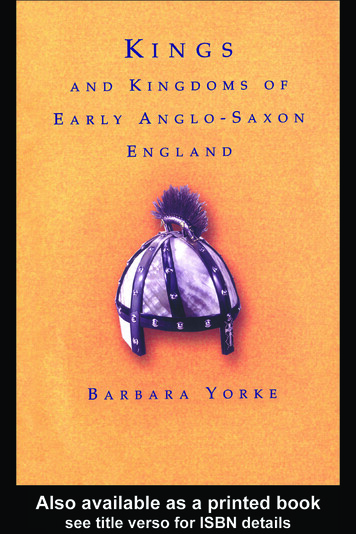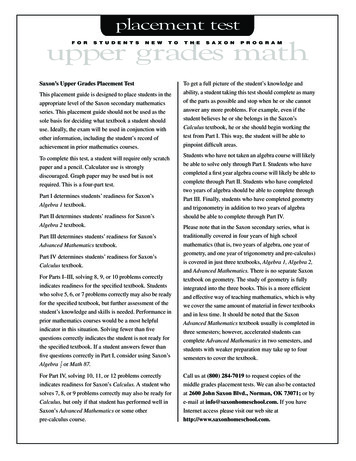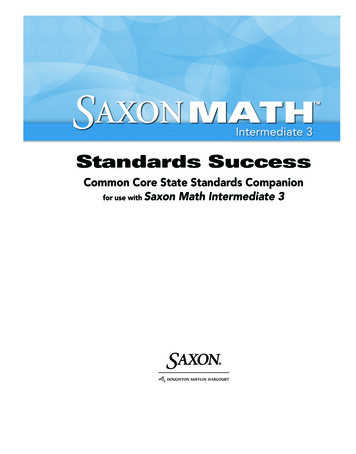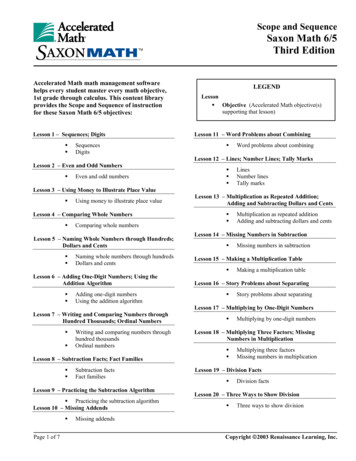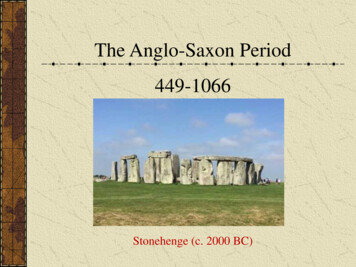
Transcription
The Anglo-Saxon Period449-1066Stonehenge (c. 2000 BC)
The Anglo-Saxons: 449–1066300s B.C.Celts in Britain55 B.C–A.D.409Roman Occupation300B.C.A.D.1A.D.300A.D. 449Anglo-SaxonInvasionA.D.878King Alfredagainstthe DanesA.D.600A.D.900A.D. 400–699Spread of ChristianityA.D. 1066NormanInvasionA.D.1200
The Celts in BritainBefore and during the 4th century B.C. Britain named for oneCeltic tribe—theBrythons Celtic religion a form ofanimism Britain home to severalCeltic tribes Druids were Celtic priests
The Roman ConquestIn 55 BC and 56 BC, Julius Caesar made hastyinvasions.True conquest, however, occurred 100 years laterunder the Roman emperor Claudius in 43 AD.Roman rule of Britain lasted for nearly 400years, ending only when Rome was threatened inItaly.The last Roman legions left for Rome in 407AD.
The Roman OccupationHadrian’s Wall – NorthEngland55 B.C.Julius Caesar invades BritainA.D. 43Celts defeated by Claudius Romans build walls, villas,baths, roadsA.D. 409Romans evacuate their troops Britain left vulnerable to attack Central government breaks downRoman ruins
Result of Roman RuleConstructed a system of well-paved roadsand founded citiesErected Hadrian’s Wall to protect fromPicts and ScotsBrought skills in the art of warfareIntroduced Roman law and orderUsed LatinIntroduced Christianity (597 AD)
Roman Rule (con’t)Roman Roads:5,000 miles of stone roadsLinked tribal capitals and townsFacilitated trade, the collection of taxes, andthe movement of troopsHadrian’s Wall:Linked the North Sea and the AtlanticHeld back the Picts and Scots for 250 years
Bathe, England
Early Anglo-Saxon LifeThe next invaders of Britain were the Anglo-Saxons:primarily the Angles, Saxons, and Jutes.These invaders were all Germanic tribes
Dispersal of the BritonsAfter the Romans left, the Britons (who were herebefore the Romans and lived under their rule inrelative peace) were unable to protect themselvesagainst their new invaders.To flee the Anglo-Saxons, the Britons fled to otherparts of the island: Cornwall, Wales, and some went toIreland.
Anglo-Saxon SocietySome highly organized tribal unitsTribes were ruled by a king chosen by a council ofelders (witan) or a leader elected by physical prowessand achievementsMany Roman buildings did become ruins though,because no one bothered or knew how to repair them.Some Saxons built wooden houses inside the walls ofRoman towns. Others cleared spaces in the forest tobuild villages and make new fields.Some settlements were very small, with just two orthree families.
Anglo-Saxon Society kinship groups led by strongwarrior chief people farmed, established localgovernments, produced finecraftwork English emerged as a writtenlanguage
The Anglo-Saxon Hierarchy Anglo-Saxon king was an absolute ruler and mighty warrior. The Anglo-Saxons had a two-class society: the thanes, or earls, who ruled andwere related to the leader of the tribe; and the churls, or bondservants, whoseancestors had been captured by the tribe. King consulted with the witan (“wise men”), an assembly of respected earls. Churls provided hard labor and were bound to the earls’ service unless theycould earn possessions and special royal favor to become freemen(independent landholders). Warriors were admired. Social organization based on strict laws and a sense of obligation to others.
The Anglo-Saxon InvasionWhy did the Anglo-Saxons settlein England?England was inviting tooutsiders: Mild climate Rich easily-tilled soil Safe anchorage for invadingships
Lived close to their animals (to protect animals andprovide warmth)Lived in single-family homes surrounding a communalhall and protected by a wooden stockade fence
Anglo-Saxon Society (con’t)The Anglo-Saxons farmed, maintained localgovernments, and created fine crafts, especiallymetalwork.Eventually, the small kingdoms developed into sevenlarge ones: Northumbria, Mercia, Wessex, Sussex, Essex,East Anglia, and Kent. (AD 600)Once the small settlements became more established andconnected, a more unified language emerged: OldEnglish or Anglo-Saxon (Germanic Origins)
Characteristics of the Anglo-SaxonsHard fighters and bold sea warriorsAdmired physical strength, bravery, loyalty,fairness, and honestyGreat love of personal freedomBoastful, willing to be cruelEnjoyed conflict, swimming matches, horse races,banqueting, drinking mead, singing songs, andstorytellingBravery in battle
The Anglo-Saxon Life Royal living quarters werea small cluster of woodenbuildings surrounded by astockade Main structure was theMead hall Mead is a fermented drinkmade of water, honey,malt, and yeast
Anglo-Saxon Life Here the king, thanes, wives,and servants gathered. Singer called a SCOPentertained with stories ofheroism. Warriors slept here afterking retired to a differentbuilding.
The Scops (pronounced sh(oh)p)The communal hall offered shelterand a place for council meetings.(Mead or banquet hall)The communal hall was also a placefor storytellers or bards (scops) whoshared (orally) the stories of theAnglo-Saxons and their gods andheroes.The Anglo-Saxons valuedstorytelling as equal to fighting,hunting, and farming.
Story TellingThe Anglo-Saxon Bards called scops strummed harp as they sang sang of heroic deeds were often warriorsWhy were the scops important? Anglo-Saxons did not believe inafterlife warriors gained immortalitythrough songsAnglo-Saxon harp
Role of WomenThe wife of an earl or thanesupervised weaving and dyeing ofclothes, the slaughter of livestock,the making of bread, beekeeping,and the brewing of mead(fermented honey).They would work alongside menin the fieldsWomen inherited and heldproperty.Married women retained controlover their property.
Types of Anglo-Saxon VerseScops often recited:Heroic Poetry: recounts the achievements ofwarriors involved in great battlesElegiac Poetry: sorrowful laments thatmourn the deaths of loved ones and the lossof the past
Anglo-Saxon BeliefsHuman life in the hands of fate (wyrd (weird)) Sharp contrast to the Christian belief in anindividual’s free willDid not believe in an afterlifeCulture: Valued honor and gloryHonor: People were judged by their actions; To berespected and remembered was the goal ofeveryone’s lifeBravery in battle
GloryImmortality only earned through heroicactionsThe goal was to be remembered after death, insongs and stories of his great deeds
The Anglo-Saxon War Culture Tribal society –warrior kings-led their men intobattle Always rival warriors within the tribe King gathered around him a retinue of fighting mencalled thanes Endless feuds between individuals and betweentribes
Anglo Saxon ValuesGold/TreasureComitatus – king and thanes/warriors tied toone anotherKing shares spoils of war, warriors obligated tofight for himLoyaltyBraveryFate Wyrd
Anglo-Saxon Beliefs (con’t)Pagan/PolytheisticThe early Anglo-Saxons worshipped ancientGermanic or Norse gods:Odin/Woden: chief of the gods, god of death,poetry, and magicFria: Woden’s wife and goddess of the homeTiu: the god of war and the skyThunor/Thor: god of thunder and lighteningFrijz/Frigga: queen of the heavensThe names of these gods survive today in ourwords Tuesday, Wednesday, Thursday, and Friday
WeaponryAnglo-Saxon armies were usually small, with only afew hundred men.The soldiers had spears, axes, swords and bows andarrows. They wore helmets on their heads and carriedwooden shields.Everyone fought on foot during a battle. It must havebeen a bit like a giant rugby scrum, with lots ofpushing and yelling, and nasty wounds.
Weaponry, Cont’dThe most feared Anglo-Saxon weapon was a battle axe,but the most precious weapon was a sword. It took hoursof work by a smith to craft a sword. He softened iron in ared-hot fire, twisted iron rods together and hammered thesword into shape.
Grave GoodsItems buried with bodies - Archaeologists can learn a lot from oldburial sites.When Anglo-Saxons died, their bodies were either cremated orburied in a grave. Belongings buried with the dead person, for usein the next life, provide evidence of the jobs people did.Men's graves include knives and spears, which suggests hunting,fighting and farming.Women's graves include tools used for sewing and weaving showing that women made cloth and clothing.The grave of a king, like the ship-burial at Sutton Hoo, was filledwith treasures, weapons and armour.
Sutton Hoohttps://www.nationaltrust.org.uk/sutton-hoo
The Coming of ChristianityIn 432, the whole of Celtic Ireland was convertedby Patrick, a Romanized Briton.In 563, a group of Irish monks led by a soldier andabbot named Columba established a monastery onthe island of Iona off the West coast of Scotland.Later, the Roman church began to send missionariesthroughout Europe.In 597, Saint Augustine converted the King ofEngland and establish a monastery at Canterbury.By 650, most of England was Christian in name, ifnot in fact.
Christianity and LiteratureThe church brought education and writtenliterature to England.Monks established churches, monasteries, andlibraries.Monks recorded and duplicated illuminatedmanuscripts, at first only written in Latin.Oral literature was transcribed into writtenform.Monks preserved not only Latin and Greekclassics but also popular literature (Beowulf).
The Spread of ChristianityAround A.D. 400 Christian monks settle inBritain Christianity and AngloSaxon culture co-exist597 St. Augustine sentfrom Rome by A.D. 699 British pagan religionsreplaced by Christianity
The Anglo-Saxon InvasionPage from Anglo-Saxon ChronicleOld English
Exeter BookA tenth-century book or codex which is an anthologyof Anglo-Saxon poetry.Survived in Exeter Cathedral libraryAmong the other texts in the Exeter Book, there areover ninety riddles.
The Venerable Bede (673-735)A monkConsidered the “father of English history”Wrote A History of the English Churchand People: the clearest account we haveof Anglo-Saxon times
Vikings8th centuryInvaded from across the North sea from Denmark and Norway867-877 Vikings invaded and took over most of northeast andcentral England
The Danish InvasionDue to rising population and limitedfarmland, many Scandinavians (the Norseand the Danes) took to the seas—theVikings.In 800, Danish raiders attacked Britain.The Norse settled in Northumbria, Scotland,Wales, and Ireland.The Danes targeted eastern and southernEngland.
Viking Raids: “From the Fury of theNorthmen, O Lord, Deliver Us”Sacked and plundered monasteriesStole sacred religious objectsBurned entire communitiesMurdered villagersHalted the growth of learningBy the middle of the ninth century, most ofEngland had fallen. The Vikings calledtheir territory Danelaw.
KingAlfredtheGreat
Alfred the GreatOnly the Saxon kingdom of Wessex managed tofight the Danes to a standstill.In 871, Alfred ascended to the Wessex throne.Alfred resisted further Danish encroachment.A 886 truce formally divided England: the Danishruled the east and north; the Saxons ruled the south.Alfred translated the Bede’s History and otherworks from Latin into English to make them moreaccessible, as well as instituted the Anglo-SaxonChronicle, a history of England from the earliestdays through 1154.
Danish ContributionsBuilt their Danelaw communities as militaryfortresses and trading centersGenerated growth of English townsExpanded English vocabulary as Norsewords crept into the languageFor example, law is Danish, and its usereflects the Danes’ interest in legalprocedures.
The Norman ConquestToward the end of the tenth century, the Danesincreased attempts to recapture and widen Danelaw andeventually forced the witan to select a series of Danishkings.In 1042, the throne returned to a descendant of Alfred,King Edward the Confessor, a Christian.Edward’s association with the Normans weakenedSaxon power.Upon his death in 1066, Edward was succeeded byHarold.William of Normandy challenged Harold’s right to thethrone and defeated Harold in the Battle of Hastings.William was crowned King on December 25, 1066.
The Norman Invasion1066 William defeats Harold and Anglo-Saxon army William of Normandy crosses the English Channel French replacesEnglish as thelanguage of theruling classThe Norman Invasion,Bayeux Tapestry
Anglo-Saxon king was an absolute ruler and mighty warrior. The Anglo-Saxons had a two-class society: the thanes, or earls, who ruled and were related to the leader of the tribe; and the churls, or bondservants, whose ancestors had been captured by the tribe. King consulted with the witan (“wise men”), an assembly of respected earls.
